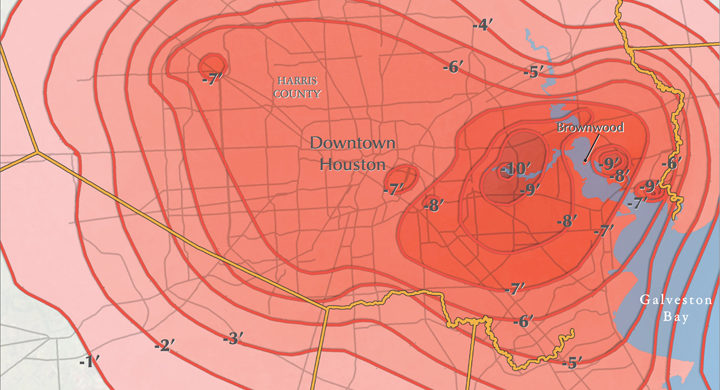
The Twenty-first Century Oil Encounter: Dispatches from Texas
Technology’s Stories vol. 5, no. 3 – doi: 10.15763/jou.ts.2017.08.27.04
PDF: Spinak_Twenty First Century Oil Encounter
Editor’s Note: This article was written before Hurricane Harvey.
Last summer’s critically-acclaimed “modern Western,” Hell or High Water, has a happy ending, of sorts. In the final scene of the film, the main character is building an extension onto his West Texas childhood home as his teenage sons come home from school. It’s a sunny day, and the new timber shines like hope against the old ranch house and well-tended yard, while the camera pans out on a peaceful landscape of waving prairie grass and brand new oil pump jacks. It may seem an incongruous pairing, but in this scene the pump jacks are a welcome presence. They are, as American Studies scholar Emily Roehl has described derricks in a previous generation’s oil-boom-Texas, “part of the family.”[1]
Hell or High Water is a powerful example of a genre scholars in the Energy Humanities have been hoping to see developed for a long time: petrofiction. First coined in 1992 by Amitav Ghosh, in a call for more literary attention to the “far-flung political, military, and cultural encounters” generated by the international oil economy, the idea of petrofiction has enabled energy humanists to interrogate different regional ways of living, knowing, and interacting in the presence of oil since it was first commercially harvested in Pennsylvania in 1859.[2]
With oil so prevalent in our lives, why would petrofiction be necessary? Ghosh’s main concern was that American corporations had structured oil production in a way that gave them the freedom to construct their own stories, or not, as they pleased. Using Abdelrahman Munif’s epic novel, Cities of Salt, as the exception that proves the rule, Ghosh argued that the bureaucratic-technocratic violence of extraction had left sites of oil production culturally bereft and therefore unnarratable.
In Cities of Salt, American oilmen take over a Bedouin oasis called Wadi al-Uyoun: in the name of progress, they first take the wadi’s water, then they take their land, and the people of Wadi al-Uyoun are soon forgotten. By displacing communities living near oil and repopulating workforces with migrant labor, Ghosh explained, twentieth-century oil companies constructed sites of production as towers of Babel – places no worker was from, where no community could be built, and where no one intended to stay. “The novel is never more comfortable than when it is luxuriating in a ‘sense of place,’” Ghosh reflected. “But the experiences associated with oil are lived out within a space that is no place at all, a world that is intrinsically displaced, heterogeneous, and international.” Though dreams of oil had thrown together continents and peoples in what should have been a culturally generative exchange, Ghosh lamented, the world had been rendered functionally mute about the significance of the “oil encounter.”[3]
Of course, oil consumers have their stories to tell, too. More recently, oil scholars have contested Ghosh’s limitation of “oil encounters” to the places where oil comes out of the ground. Oil’s places of production may be traditionally dis-placed as Ghosh described, but the sites of consumption have been so pervasive for so long, they contended, that petrofiction should be a much bigger category. Energy Humanities pioneer Imre Szeman even claimed that American culture is so steeped in the consumption of oil and oil-based products – based on a deep-rooted “fiction of surplus” – that petrofiction was not a genre but rather a periodization, encompassing all twentieth-century American literature, from, say, The Great Gatsby to the recent proliferation of dystopian climate fiction, or CliFi. Oil has so entangled us in an idea of energy as synonymous with progress, Szeman further argued, that our literature has been largely incapable of critique. This includes the ability to imagine a world without oil, beyond substituting as-yet-undiscovered forms of energy as a techno-fix, except as a dystopia.[4]
And yet, in twenty-first century America, it is becoming less necessary to delineate sites of production and consumption in search of the “oil encounter.” Technological improvements in extraction of “unconventional” oil combined with the exhaustion of earlier reserves, stress on rural economies, and the ever-present politics of energy independence have been rapidly reshaping much of the American landscape into intimate landscapes of oil extraction, interspersed as well with other forms of energy production.[5] (If you keep driving west from the region of Texas captured in Hell or High Water, pump jacks soon give way to miles upon miles of industrial wind farms.) At the same time the oil industry is increasingly taking an inclusive approach to public outreach. In this curated worldview, oil has room for everyone and is synergistic with “nature.” Bringing Ghosh’s insights into the twenty-first century, as the petroleum industry expands into new frontiers of unconventional oil, it is clear that the “oil encounter” has come home to the United States. Mediated by multinational oil corporations and finance, oil production is increasingly rejoining the sprawling decentralized landscapes of consumption it has been complicit in creating over the last century (see Figure 1).[6]

Figure 1: Oil Wells (including offshore), Pipelines, and Refineries in the United States, 2017. Source: U.S. Energy Information Administration. (Make your own maps of energy resources, production, and distribution here: https://www.eia.gov/state/maps.php.)
Historically-speaking, the absence of energy production from everyday life is an unusual state of affairs. Under pre-industrial energy regimes, most of the U.S. would have been a mixed landscape of energy production and consumption, relying on timber, charcoal, animal fats, feces, and labor, and other energy-rich sources from living organisms. Unlike subterranean deposits of mineral energies such as oil and coal, trees and animals need space, sun, water, and time to become useful for human needs. They are also difficult to store and transport. Older, organic energy regimes were thus by necessity landscapes of mixed production and consumption. Only in cities were people freed somewhat from the demands of securing their own energy stores in situ.[7]
In the early twentieth century, the new high energy economy made possible by oil and electricity was supposed to even out rural-urban discrepancies in quality of life. Between newly accessible oil, which – after boom markets encouraged some creative inventing – could be easily stored and shipped, and advances in electricity transmission, which allowed for centralized generating plants serving hundreds of miles of powerlines, energy access took on the quality of a public good. Well separated from the raw and oily sites of extraction and the smoky sites of generation, rural communities still reliant on organic energy were painted as unacceptably backwards, though desirable, places to live. Mineral energy promised to relieve rural drudgery on the farm, improve sanitation and food storage, connect people to the cities and to each other – in short, it would bring the culture of the city to the bucolic health of the country, with few drawbacks.
At the same time, the possibility of a high-energy countryside fueled anti-urban sentiments. Automobiles and farm machinery in combination with radios and mechanized household appliances made dense congregations of people and industry also seem antiquated to urban reformers. On the campaign trail, Franklin D. Roosevelt waxed poetic in the 1930s about the elimination of “sweatshops and slums” through a more even distribution of everything in the countryside: through becoming more intensive energy consumers, all Americans could have a good job and own land, and the national economy would grow, too.[8]
Of course, we know now that the contradictions built into these sprawling landscapes dependent on the efficiencies of decentralized energy would eventually lead to chronically depressed rural economies. After a century of consolidated agribusiness and the flight of rural manufacturing, oil has once again brought the promise of capital to the countryside, this time not in the modern efficiencies it brings in, but in its ability to be taken out.
What does it mean to be part of the production apparatus for the global oil industry? How should we interrogate the growing variety of ecotechnological landscapes of agrarian oil, wild oil, and oil domesticity that are part and parcel of twenty-first century American modernity?
Here, Texas can be of help. In the great state of Texas, oil production has met consumption in a sprawling boom-and-bust landscape of used-up wells and newly-discovered caches for a hundred and fifty years.[9] In Texas and other historically oil-producing states, stories about oil in everyday life have been told not just in fiction but in their landscapes and institutions, from the “moveable art” (Figure 2) of Luling, Texas, to the incongruous celebration of local economies in the Louisiana Shrimp & Petroleum Festival, held annually since 1967. In search of the stories we tell ourselves about oil, and the stories we tell ourselves about ourselves in the context of oil and its externalities, I examine in this essay three twenty-first century cultural artifacts across different media that grapple with oil production in Texas. In doing so, I propose a few ways of seeing the twenty-first century American “oil encounter,” and suggest that encounters between, say, international finance and displaced communities are worth examining as much as those between American company oilmen and Bedouin herders.

Figure 2: Totally not a metaphor: a terrified fish swims away from a shark while an oil well does its job, in one of many pump jack art projects commissioned in Luling, TX. See other examples of “moveable art” on pump jacks around Luling in the original article here: https://www.texastribune.org/2014/02/28/luling-pumpjack-art/. Photography: Todd Wiseman for The Texas Tribune. Used with Permission.
Oil Encounter #1: Baytown Nature Center
I have been studying energy history for several years now, but I thought surprisingly little about oil until I lived in Houston. Once there, it was impossible not to. Houston is an oil-soaked city. Oil runs deep in the veins of its financial downtown, underwrites the city’s arts and education, and maintains its sprawling urban logic. If you drive east, refineries quickly dominate the horizon, as vast as a mountain range in relief against the swampy, sea-level city. Heading west, you quickly encounter the office towers of the “Energy Corridor.” An hour south, off the coast of Galveston, oil production continues apace on deep sea drilling rigs. Even the flowers that bloomed in the Houston spring outside my apartment smelled vaguely of petroleum.
Between Houston and the refineries to the east, a small spit of land sticking into the shipping channel offers a rare outpost of public green space in an industrial landscape. The Baytown Nature Center, a 450-acre peninsula of winding trails, marshes, and canals, promotes itself mainly as a bird sanctuary. (As of 2017, at least one small alligator also called the park’s swampy alcoves home.) Though across the water, the smokestacks, storage silos, and conveyer belts of the petrochemical industry dominate the horizon, much of the Nature Center feels timeless in the way that protected wilderness so often does (see Figure 3). If you found yourself there by accident, the information pamphlets and maps available at the park entrance would not prepare you for the other discoveries you might make on a hike around the park: manhole covers on hiking trails, a stretch of pink bathroom tile near a picnic area, crumbling foundations peeking out of the waves just offshore (see Figure 4).

Figure 3: Refinery smokestacks and silos span the horizon in front of marsh grass and waterfowl at the Baytown Nature Center. Photography: http://birdingacrosstexas.blogspot.com.[10]
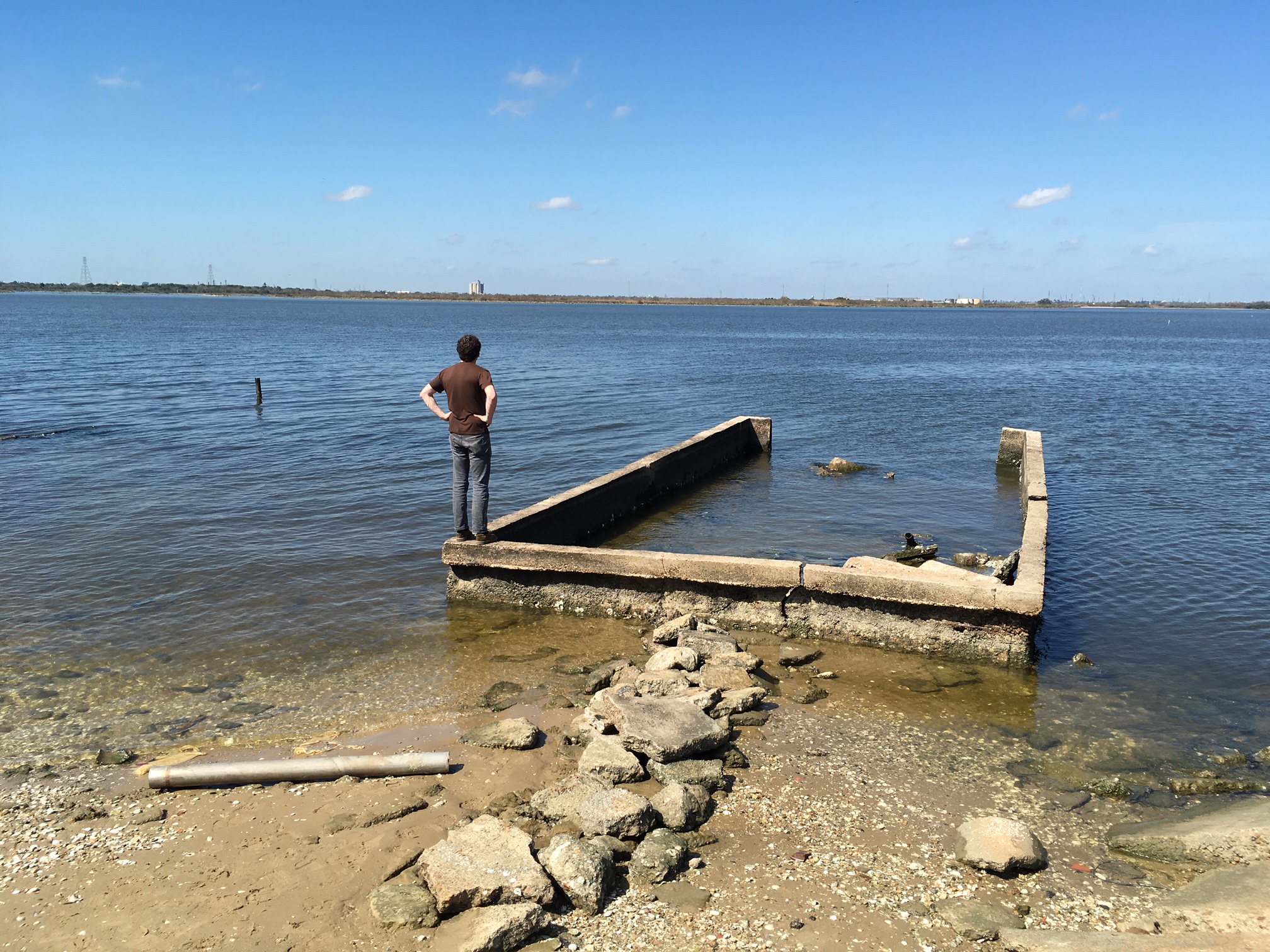
Figure 4: Formerly waterfront property at the Baytown Nature Center. Photography: Rachel McDonnell.
Baytown Nature Center used to be a posh housing development called Brownwood and populated by oil executives from Humble Oil (later Exxon).[11] It was a surprisingly pleasant spit of land to live on despite its proximity to the refineries. The commute was short, and, as W.C. Smith recalled at a Brownwood neighborhood reunion in 2002, the winds were such that you “never will smell Exxon.”[12] Former residents recall idyllic childhoods, where neighbors knew each other, and they were always in the water. Turtles, owls, and waterfowl made their homes in lush lawns next to the horses and chickens of nature-loving suburbanites who flocked to Brownwood. In the evenings, residents would sit in their backyards and “wave at the Esso tankers” coming up the shipping channel.[13]
By the 1970s, there were 360 homes in Brownwood, and the neighborhood had diversified. The beauty of Brownwood encouraged creativity: when Kay Carter’s family fell in love with the neighborhood as renters, but couldn’t afford to buy there, her father made a deal for a swampy plot and trucked in sludge from Exxon to make landfill solid enough to hold a house. “Carter’s Folly,” neighbors dubbed the sludge hill where their family home eventually stood.[14]
Even with the free landfill, the oil industry would prove to be the death of Brownwood. The land around Houston is basically a sponge. But when a sponge dries, it shrinks. As industrial operations intensively consumed groundwater from the peninsula on which Brownwood was built, the neighborhood subsided 10 or more feet between the 1930s and 1980s. Flooding became more frequent, and, in the 1970s, the city of Baytown initiated talks about relocating the neighborhood.[15]
Many residents resisted moving. Instead, they created “survival civic associations” and petitioned the town for infrastructure upgrades to protect them from the encroaching bay. Brownwood flooded so much in those years that it had become part of the neighborhood identity to be willing to rebuild (see Figure 5).[16]
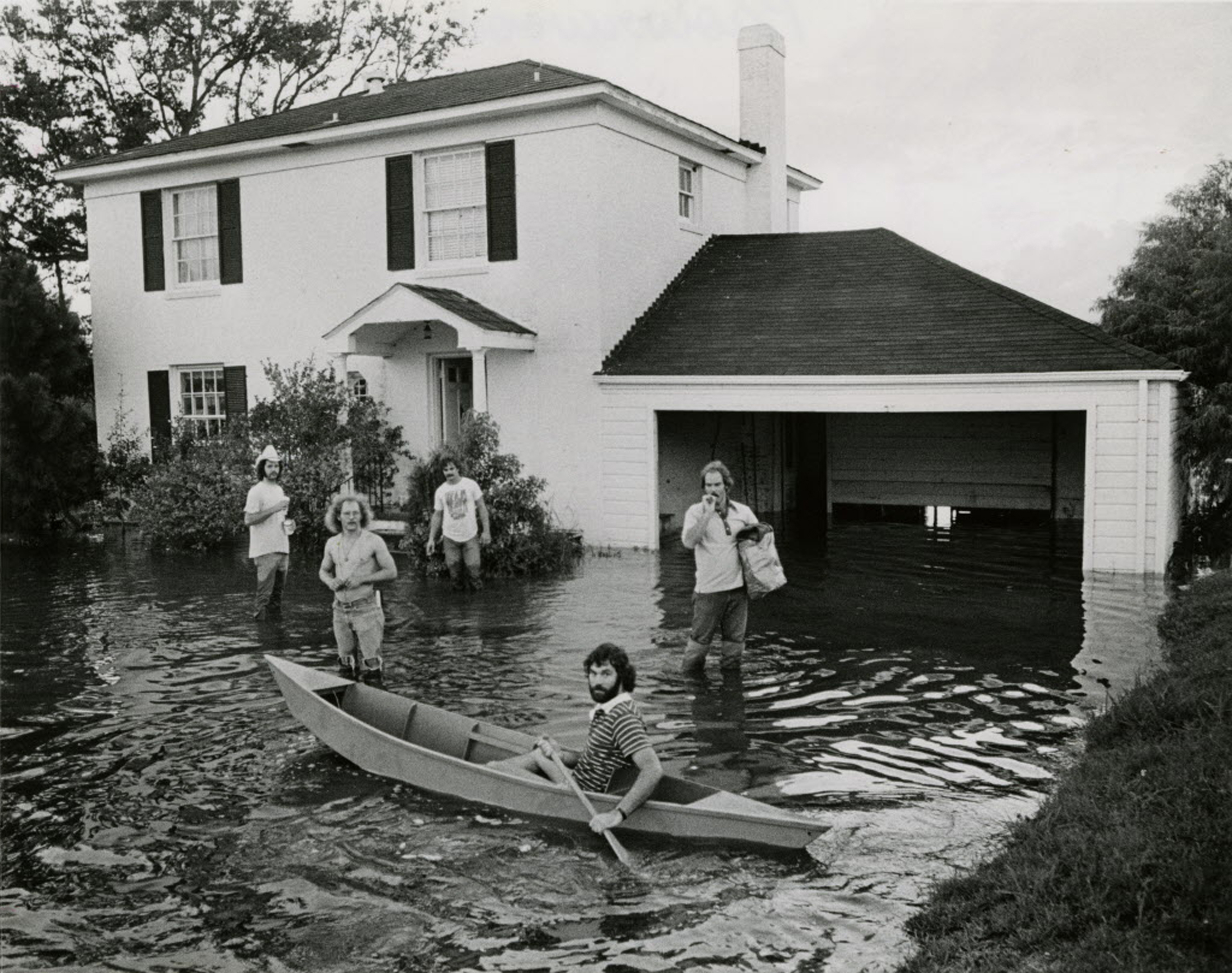
Making the most of flooding in Brownwood in 1977. Photography: Othell O. Owensby Jr./©Houston Chronicle. Used with permission.
Hurricane Alicia eventually sealed its fate: after three-quarters of the houses were destroyed or damaged in the storm in 1983, the federal government bought the property from the remaining resilient residents. In the 1990s, the city razed the damaged structures that still stood as reminders of the peninsula’s residential past and eventually built the Nature Center, open to the public every day except Christmas.[17]
Baytown Nature Center tells its stories in its silences. There is no information in the park or its brochures about the peninsula’s residential past. As an “oil encounter,” it is, in Michael Rubenstein’s typologies, “unspoken [and] unspeakable, at once too close, too far, and too immense to be immediately perceptible”[18] You still can’t smell Exxon there: an American counterpart to Cities of Salt, Brownwood residents first lost their water to oil, then they lost their homes, then they lost their heritage.
While the Nature Center may be mute about its past, however, Brownwood has been in the news a lot recently, not because of anything new on the peninsula, but because Houston has been flooding. In the last couple years, the sprawling metropolis has had multiple “100 year rain events” in the same week; Houston’s 2016 “Tax Day” flood, which made national news, was estimated to be a “10,000 year” event.[19] In the wake of increasingly severe storms, Brownwood has become Houston’s Easter Island, its cautionary tale about the hubris of bad infrastructure planning and rapid development. Land that has subsided due to groundwater depletion doesn’t “bounce back,” meaning that industrial uses of water in the Houston area have irrevocably lowered the elevation of Brownwood and other neighborhoods, and this unintended effect has major consequences for a coastal city in an era of sea level rise and extreme weather events.[20] As more of Houston floods more frequently, it sees its fate in the tiny spit of land that once housed oil executives and was lost to their inattention to the land outside their doorstep.[21]
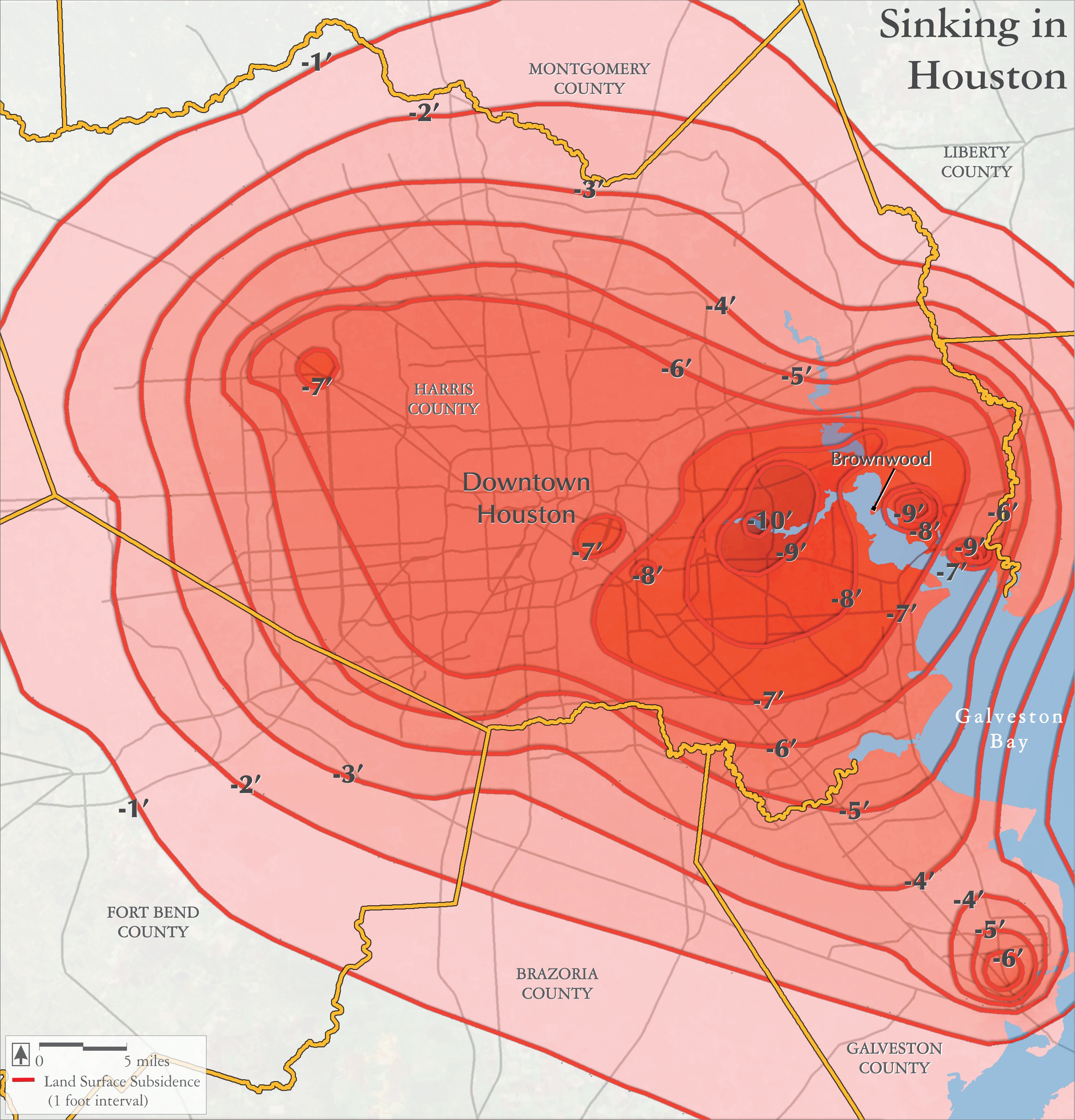
Figure 6: Subsidence in the Houston Area, 1906-2000. [22] Source: Texas Landscape Project. Used with permission.
An hour south of Baytown, the promise of good living amidst oil production is alive and well in the Ocean Star Offshore Drilling Rig and Museum in Galveston, a port city that once rivaled Houston as the metropole of South Texas.
The offshore oil rig may be the most placeless of places within the geographies of oil, and yet the oil industry tells stories, too: about the place of oil in nature, about the place of people in oil. Perhaps theirs is, in fact, the dominant narrative.
I visited the museum with friends from Boston on a cold and blustery day in March, when the unseasonable chill made Galveston’s industrial beaches even less appealing, as if the prominent pipelines paralleling the shoreline were not deterrent enough.
The Ocean Star has a 4.5/5 rating on tripadvisor, making it the #5 thing to do in Galveston. It is still waterborne, accessible via a gangplank off a pier, past nesting pelicans, and through a gift shop selling drill bit earrings and coffee mugs. The museum itself consists of three floors, split into indoor curated exhibits and outdoor deck tours of the derrick, the drilling equipment, and the operational and safety apparatus. We were delighted to find equipment named such things as the “Iron Roughneck,” “BOP Accumulator,” and, my personal favorite, the “Kelly / Kelly Bushing.”
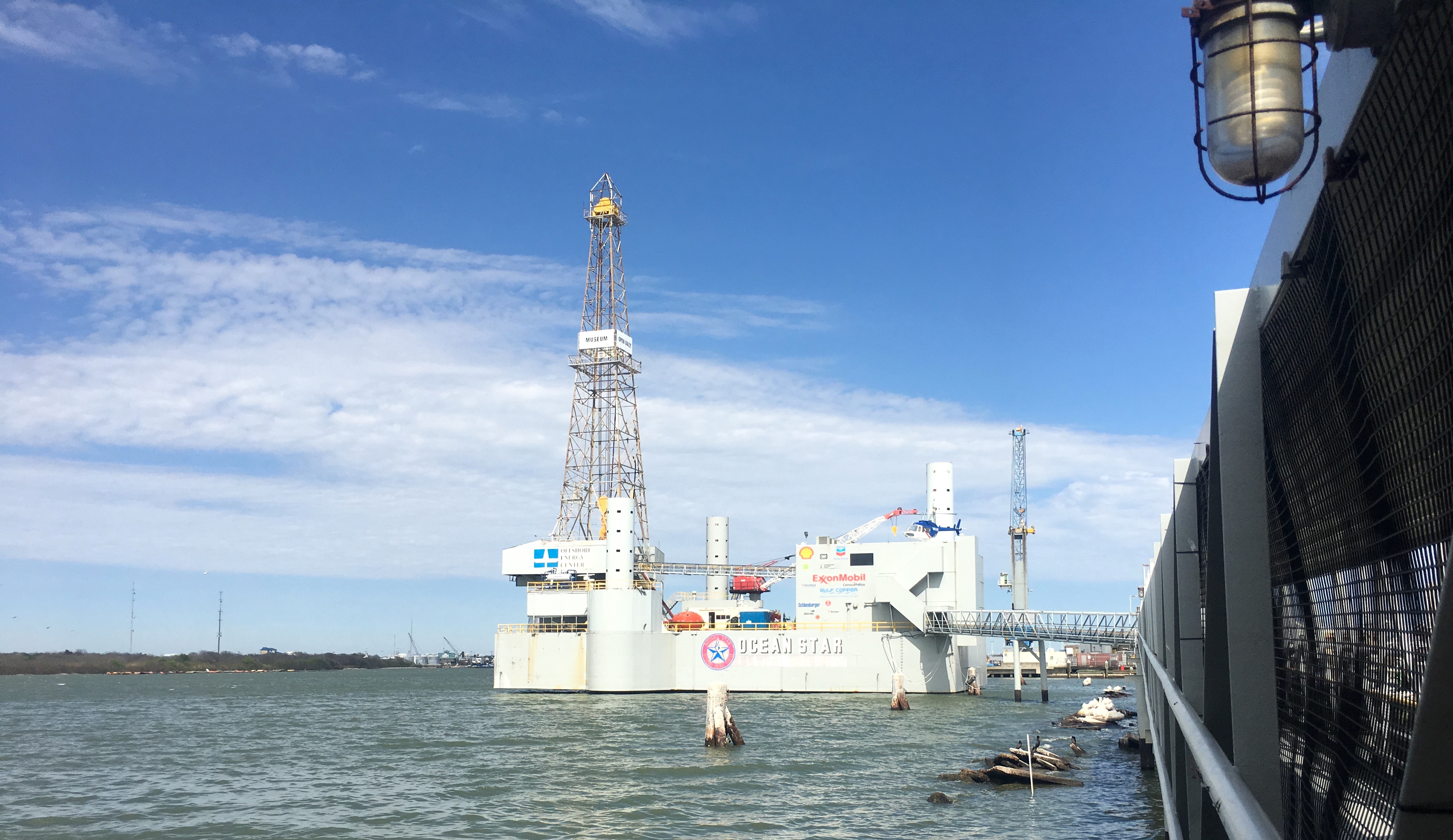
Figure 7: The Ocean Star from the Galveston docks. Photography: Michael Baym.
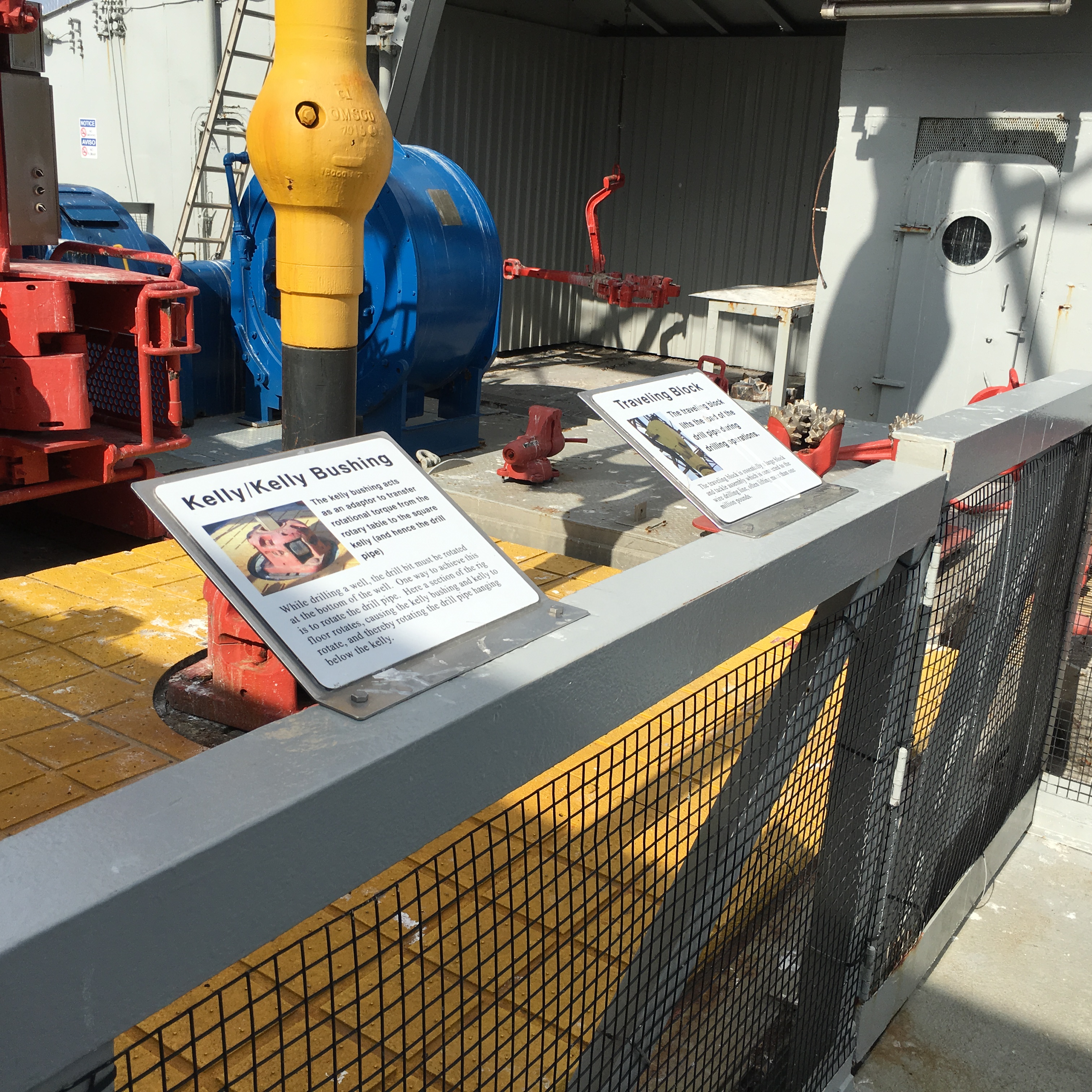
Figure 8: The offshore drill assembly explained. Photography: Michael Baym.
Inside, corporate sponsorship rules the exhibits. Perhaps the kindest thing to say about the museum is that it doesn’t try to hide its bias: its wall of corporate sponsorship includes BP, Halliburton, Schlumberger, Shell, Texaco, and others. Still, the Ocean Star promotes the kinds of facts that have led some to call Donald Trump the first postmodern president.[23] The tour starts with a fifteen-minute video on the history and technology of deep-sea drilling, from which you learn that oil seepage is “natural” and has occurred without the help of humans for “millions of years.” It is extracted from the sea floor with the help of “drilling mud,” which only from fine print does one discover is a customizable industrial slurry. In the Environmental Area, you find that oil rigs provide safe habitat for juvenile fish, crustaceans, and mollusks. (“What lies beneath the shimmering blue waters of the Gulf of Mexico,” the exhibit boldly proclaims, presumably about both fish and oil, “is a world waiting to be discovered.”)[24]
While diversity of perspective on the societal impact of offshore oil may not be welcome onboard the Ocean Star, the museum tries hard to be an inclusive space in other ways. The Career Corner has suggestions for how any personality type can find a satisfying place in the oil industry, whether you are “Realistic”, “Investigative”, “Artistic”, “Social”, “Enterprising”, or “Conventional.” The “Life on a Rig” exhibit invites you to imagine yourself as part of a jovial crew, where everyone has their special role in maintaining the high-tech floating city that ensures a steady oil supply (but also where there is plenty of fun to be had after hours). And, of course, following a more standard “fiction of surplus” narrative, the Ocean Star’s “How Do You Use Oil?” diorama reminds the visitor that petroleum binds everyone together through the material comforts of a good American life: a blond Barbie doll in a bikini luxuriates amidst petroleum-based sunscreen, high-heels, golf balls, laundry detergent, paint, electronics, and crayons.[25]
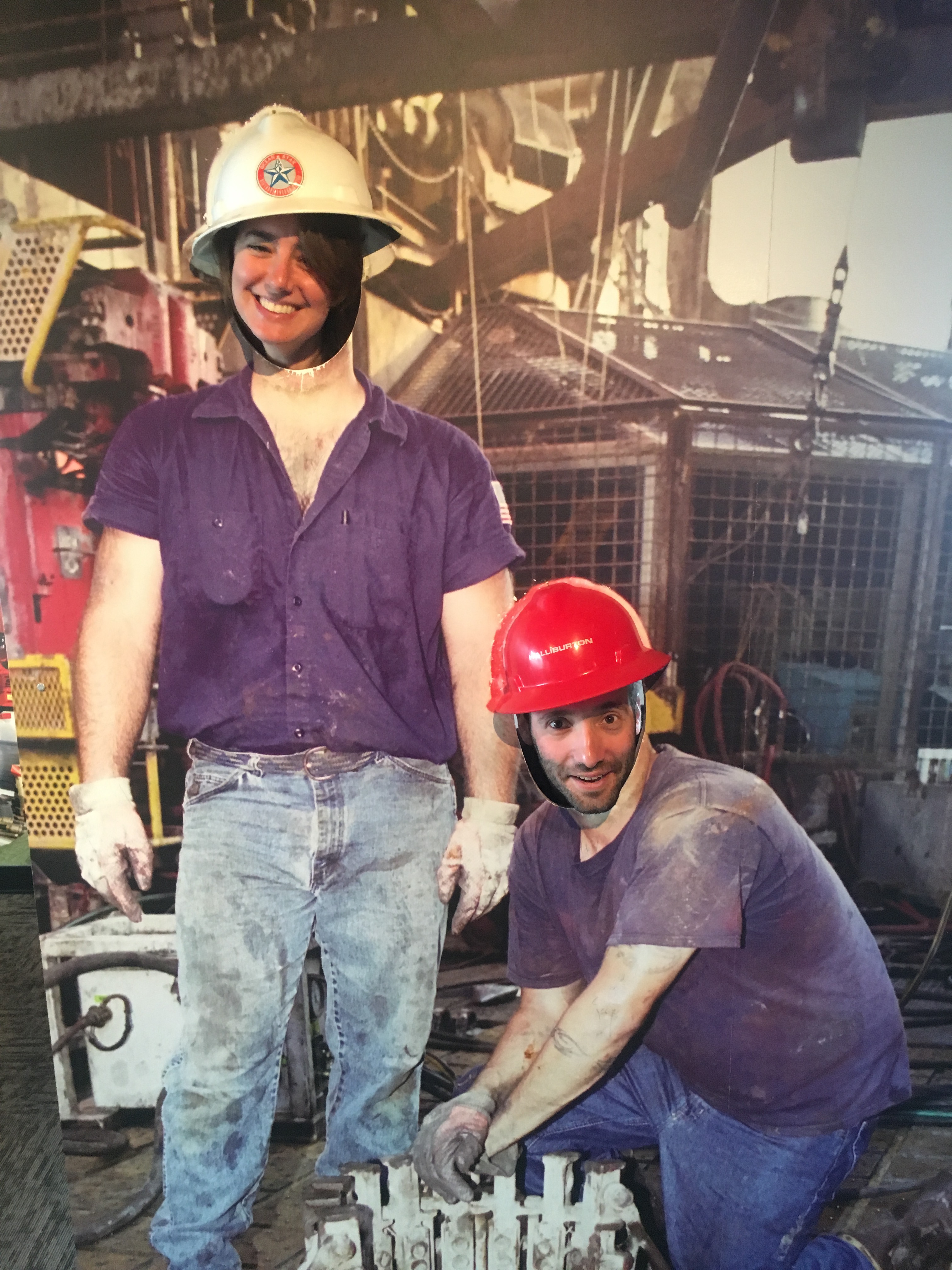
Figure 9: Imagine yourself in the offshore industry! (We were probably the wrong audience for this exhibit.) Photography: Britt Harter.
But perhaps the Ocean Star’s most notable foray into reframing the American oil encounter has been in its public outreach. The Ocean Star has been commended as a best practice example of changing public perceptions of the oil industry. In 2008, for example, an editor of the trade publication Drilling Contractor highlighted the Ocean Star in her article, “Oil/gas industry knows it has a crisis of image. At last, we’re really doing something about it.” The article begins:
“IN A WORLD where perception is often reality, an industry that is perceived, albeit unfairly, as dirty, dangerous and greedy can suffer a crisis of image that threatens its foundation and future. But getting the truth out can be a challenge. …Industry leaders recognized it was time to educate the public and policymakers in a big way about a little-known truth: Oil and gas drilling is safe, clean and technologically advanced, and earnings are being reinvested in exploration that costs billions of dollars.”[26]
No matter your politics, there is a sublime quality to offshore drilling, which the Ocean Star indulges in its beautiful panoramas, model rigs with exquisite detail in miniature, and equipment displays.[27] And yet, the billions of dollars of exploration, the massive offshore cities built only for extraction, the technologies required to go “ultradeep” for oil feel pornographic in display as much as they do impressive.[28]
Rethinking deep-sea drilling as a triumph of capital as much as a triumph of technology raises potential contradictions that trouble the future of oil. The need to spend “billions of dollars” on deep sea oil exploration to keep the industry afloat to some might be less a sign of the cutting edge of technology than a symptom of the “progressive closure” of “capitalism’s Cheap Nature frontiers.” “Cheap Nature” is a term coined recently by geographer and political ecologist Jason W. Moore to better examine the structural relationships that have led to endeavors like deep-sea drilling. Cheap Nature builds on Marxian ideas of “primitive accumulation” – the dispossession of land and labor power that created a proletariat, a class dependent on wage work and the market for a livelihood – and refers to the extensive resources (which include, Moore highlights, many of the displaced peoples) appropriated through force or taken for free as “raw materials” that have gone into creating the worlds’ commodities and enabled capital accumulation. Even as he details the violence of an economic system reliant on continual inputs of Cheap Nature, however, Moore suggests that this “audacious act of global bookkeeping” may be reaching its end.[29]
If so, the oil industry’s self-promotion subsequently becomes, not a celebration of human ingenuity, but a testament to the lengths to which people will go to keep an industry alive. What is clear is that, within the American oil industry and the regulatory state that manages it, the boundaries between raw materials and wilderness, and between raw materials and spaces of domesticity, are rapidly thinning.
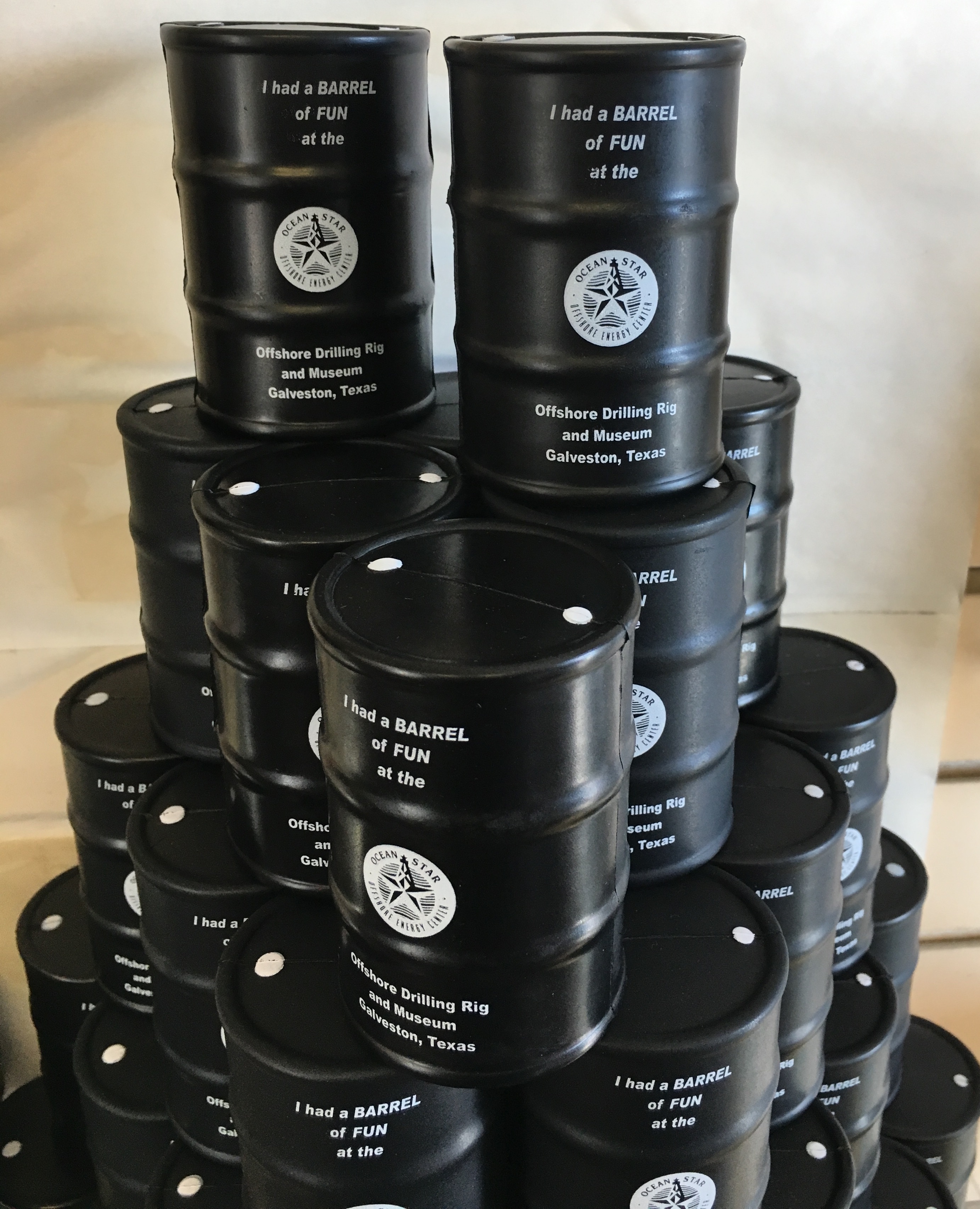
Figure 10: Souvenirs from the Ocean Star, naturally, increase the presence of petroleum in your daily life. Photography: Michael Baym.
Oil Encounter #3: Hell or High Water
Which brings me back, finally, to Hell or High Water, a standout 2016 indie film that was nominated for four Oscars, and which I think everyone should see. While I claim the movie as petrofiction, screenwriter Taylor Sheridan intended it to highlight the impacts of the recession and mortgage crisis in post-2008 rural America. Sheridan is from Texas, and he appreciates the fact that the sparse landscape, the lax gun laws, and the libertarian culture of his home state meant that setting a movie in modern Texas makes it read inescapably as a Western. He sees the region as one plagued by cyclical dispossession, and initially named the film Comancheria. [30] Sheridan has one of his characters, a half-Comanche, half-Mexican Texas Ranger (as in law enforcement, not baseball), explain the parable as he gazes at a branch of the fictional Texas Midlands Bank across the street from the lone diner in a depressed town: “A hundred and fifty years ago, all this was my ancestor’s land, everything you can see, everything you saw yesterday, until the grandparents of these folks took it. And now it’s being taken from them. ‘Cept it ain’t no army doing it, it’s those sons of bitches right there.”
Hell or High Water is structured as a bank heist meets buddy road trip film about two brothers, Toby and Tanner Howard, struggling to keep their family’s ranch after their mother dies with about $40,000 of debt to Texas Midlands. It is implied, though never explicitly stated, that the debt is the result of some combination of medical bills from the mother’s lingering illness, which kept her bedridden for months, and Toby’s decision to take care of her at the expense of the ranch. Desperate and facing foreclosure at the end of the week, the brothers come up with a plan to rob several small-town branches of Texas Midlands and “pay those bastards back with their own money,” as their lawyer says late in the film – to which he adds admiringly: “Well, if that ain’t Texan, I don’t know what is.”
In the film’s sparse slow dialogue, it unfolds over time that the brothers are acting out of more than sentimental attachment to family land and a few “skinny cows.” Chevron has identified an oil deposit on their land and wants to lease it for drilling. It’s a big find – an estimated 2000 barrels a month – and Toby seizes on this lease as a way for his sons to escape the grinding cycle of rural poverty he feels has plagued his family “like a disease, passing from generation to generation.”
Film reviewers get a little lost in the financial details of the film, and that itself is a testament to Sheridan’s penetrating vision of rural American modernity.[31] The plot hinges on administrative red tape: Texas Midlands has placed a lien on the cattle ranch that has been in the family for at least three generations. The brothers owe back taxes and need to pay off their mother’s reverse mortgage. Chevron wants to lease the land to drill for oil, but the Howards can’t sign a lease agreement with Chevron until Texas Midlands releases their lien. The bank is threatening to foreclose, which would mean ownership of the ranch would revert to the bank, and the bank would then reap the oil revenues. It is both excruciatingly technical and the oldest story of injustice under capitalism: the struggling poor are increasingly dispossessed of assets at the moment those assets become economically productive.
However, Sheridan made the Howards extremely lucky in one respect. Unlike many of their fellow Americans caught up in the shale oil and natural gas booms of recent years, they own the oil beneath their land. Statistically-speaking, given the history of surface-versus-mineral rights across coal and oil country, and the lack of legal precedent on who must be compensated for new methods of drilling and fracking in what contexts, the discovery of oil on the Howard ranch should have been nothing more than their latest tragedy in a bad year. More likely as not, the brothers would have failed to realize that their land ownership documents pertained only to surface use and would not have been informed when Chevron or someone else purchased the ranch’s mineral rights. They would have discovered this oversight when Chevron started taking advantage of the variety of easements for surface use mineral estate holders enjoy for accessing their subterranean property.[32]
But the destruction of an impoverished ranch by a big oil company with little recourse to compensation would not make for a good bank heist movie. On this West Texas ranch, oil means income, as long as the Howard brothers can get the bank to release the lien on their land so that they can lease it to Chevron.
Hell or High Water is petrofiction not because it is about oil per se, but because oil forms the backdrop of all else that could possibly happen in the serially monocrop economy of twenty-first century West Texas. The title card of the movie, a stolen car filled with stolen money racing through a field of pump jacks, proclaims this dependency loud and clear (see Figure 11).

Figure 11: Title Scene, Hell or High Water
Oil is the deus ex machina of Hell or High Water, mediating between a broken health care system and bank debt, and it is not a benevolent one. It’s worth the quick reminder that Chevron, the faceless savior in this particular story, is one of the main corporate perpetrators of environmental risk that led to the rise of the environmental justice movement in the 1980s, ultimately forging long-distance connections between activists across borders: for example, between sites of extraction in Ecuador and the urban backyard of a major Chevron refinery in Richmond, California.[33] The happy ending in which the Howards get oil instead of affordable health care is ultimately a damning statement on modern American life, as well as on the possibilities of the American “oil encounter” in the twenty-first century.
In fact, the film warns you early on that its happy ending is tenuous at best. After the first morning of successful heists, Toby lingers at a diner, where a sweet but tired-looking waitress strikes up a conversation. Being post-recession Texas, it quickly trends towards the vagaries of the energy industry:
“What do you do?” the waitress asks, just making small talk.
When Toby tells her his “last job was for a natural gas company,” she responds with admiration, “Sounds high dollar.”
“No, there ain’t nothing high dollar about drilling,” he replies. “No one seems to be drilling for gas now anyway.”
“They’re sure drilling for oil,” she protests, indignant on his behalf. “I mean, ain’t one drill the same as the next?”
He smiles: “That’s my take on it. Guess I gotta get someone else to believe me.”
“We could use a cook,” she says sympathetically, handing him the check. “Just a thought.”
Ironically, when Hell or High Water was being filmed in 2015, oil producers in Texas were in panic mode. In November 2014, the Organization of Petroleum Exporting Countries (OPEC) discontinued its long practice of curbing oil production to maintain price stability, hoping to put pressure on America and Canada to take on the role of “swing producers” by limiting their development of unconventional resources. The repercussions of OPEC’s decision were still rocking the world’s oil markets when the film started airing at festivals in the spring of 2016. Oil prices were still plummeting, companies across Texas were laying off workers, and production had measurably slowed. At its nadir early in 2016, oil sold for less than $30 a barrel, much lower than the break-even point for many of the new wells brought online in the Comancheria area of Texas. [34] Whatever the terms of Chevron’s lease agreement with the Howards that Sheridan imagined when he was writing the screenplay at oil prices of $100/barrel, it is impossible, given the state of oil geopolitics when the film was in theaters, that the Howards’ wells would actually have been producing the $50,000 per month the movie claimed was going into the trust Toby sets up for his sons.[35]
Stephanie LeMenager describes the recent waves of small-scale oil extraction in Texas as “reminiscent of the frontier mining towns of the nineteenth century.”[36] Environmental, labor, and property laws have yet to catch up, and towns with little else sustaining them have grown accustomed to living by the boom-and-bust rhythm of a largely unregulated oil economy. In years when oil prices have been high, minimum wage in Texas oil towns has soared well above $15/hour. When it has dropped, as in the last couple years, vacancy signs go up and mortgages are foreclosed.[37]
Hell or High Water is profoundly resonant as a story for our time because the real drama of the movie is not the bank heist, nor the wild west chase scenes, but rather the slow violence of bureaucracy. The climax of the film comes after Tanner’s shootout with the Texas Rangers – that’s merely a distraction, as Tanner himself well knows; it is, instead, the moment when Toby refuses to leave the Childress branch of Texas Midlands until he sees with his own eyes the bank executive fax confirmation of a release of lien to his lawyer, who is brokering the lease with Chevron. As Ghosh observed 25 years ago, the pivotal action of petrofiction is still found in the details managed or conveniently neglected by middle managers in quiet air-conditioned office buildings.

Figure 12: Price of Oil per Barrel from January 2012 – August 2017.[38]
Re-encountering Oil in the Twenty-first Century
What can we learn from these American “oil encounters”? From the new landscapes of production? From the cultural spaces built on oil ruins – the museums, the wildlife sanctuaries?
In Hell or High Water, oil production is the basic infrastructure of the modern Western, an unglamorous encounter between rural poverty and global finance that is merely playing out the latest structural episode of colonization and displacement. On the Ocean Star, oil production is beautiful, natural, benign, and holds a place for everyone. Without the distance of time or space, truth is still political there – power scripts the encounter and the materiality of production is hidden in innocuous terms like “mud.” In Baytown, the encounter is a silencing. A place where hundreds of employees raised their families, sat on their docks, gazed across the bay, has been rewritten to be a timeless sanctuary, proof that industry and wildness can peacefully coexist. In these aquatic-industrial spaces, in the ruins of sunken neighborhoods, around the perpetual motion of pump jacks, new life flourishes, but nothing is sacred about what has been displaced.
Unless we can build new civic norms that encourage meaningful conversations about structural change, the future will likely hold a much more integrated built environment of production and consumption – on the techno-optimistic end, solar-powered roof tiles sending energy to a Tesla home battery that powers our self-driving cars and feeds energy back into our neighborhood microgrid when necessary; on the eco-pessimistic end, an unrelieved landscape of drilling and fracking in our backyards, national parks, and waterways, interconnected by a transcontinental spider’s web of corporate pipelines on federal lands repossessed from those least able to fight for it. Somewhere in the middle is cows and children playing happily around pump jacks that allow small ranchers to keep their private lands from being repossessed by the rural arms of international finance.
Honestly, these are not as different as one may think: all have the capacity to be quite dystopian. Imagine, for example, the potential externalities of a “like Uber, but for solar!” energy economy. They are connected in their shared visions of encounter, in reconnecting production and consumption in a way that makes market sense. The problem is, things tend to make market sense when they provide areas of market growth – that is, commodifying formerly non-market or quasi-market amenities, such as open green space and the household, groundwater, or the ocean floor.
If this is indeed our future, then the twentieth century’s silences on the cultures of oil production will represent a strange period of American history, where energy production and consumption were spatially separate, in some places, for some people. Examining how cultural meaning is made at the sites of oil production is thus critical for teaching us to start conversations about the future of production in our daily lives.
The big lesson as I see it is this: imagining a world without externalities from energy production is naïve. Renewables won’t get us there; the only realistic practices that will are policies of degrowth and culture shifts towards reduced consumption.[39] If that isn’t a path we can stomach as a society, then we need to have serious conversations about fair property rights and meaningful compensation, as well as more authentic spaces to collectively envision and debate what we want our world to look like, and at at what cost.
Abby Spinak, Ph.D., is a Lecturer in Urban Planning and Design at the Harvard Graduate School of Design. She usually writes about the political economy of electricity and the history of cooperatively-owned utilities in the United States, but recently learned to pay attention to oil during her year as an Andrew W. Mellon Postdoctoral Fellow in the Energy Humanities at Rice University.
Bibliography
Archival Sources:
Thomas G. Corcoran Papers. Library of Congress, Washington, D.C.
Video Interviews of Brownwood Subdivision Former Residents. Sterling Municipal Library, Baytown, TX.
Published Sources:
Belliveau, Michael, Michael Kent, and Grant Rosenblum. Richmond at Risk: Community Demographics and Toxic Hazards from Industrial Polluters. Citizens for a Better Environment, 1989.
Caudill, Harry M. Night Comes to the Cumberlands: A Biography of a Depressed Area. Boston: Little, Brown and Company, 1962.
Danbom, David B. The Resisted Revolution: Urban America and the Industrialization of Agriculture, 1900-1930. Ames: Iowa State University Press, 1979.
Dowell, Tiffany. “Surface Owners Beware!” Texas Agriculture Law Blog. Last modified August 19, 2013. http://agrilife.org/texasaglaw/2013/08/19/surface-owners-beware/.
Farquharson, Danine. “North Atlantic Sublime: Possibilities and Pitfalls for Ocean Policy.” Presentation at Cultures of Energy 6, the Annual Symposium of the Center for Energy and Environmental Research in the Human Sciences Annual Symposium, Rice University, Houston, TX, April 13-15, 2017.
Ghosh, Amitav. The Imam and the Indian. New Delhi: Ravi Dayal, 2002.
Jones, Christopher F. “A Landscape of Energy Abundance: Anthracite Coal Canals and the Roots of American Fossil Fuel Dependence, 1820–1860.” Environmental History 15, no. 3 (2010): 449-84.
—. Routes of Power: Energy and Modern America. Cambridge: Harvard University Press, 2014.
Galloway, Devin, David R. Jones, and S. E. Ingebritsen. “Houston-Galveston, Texas.” Land Subsidence in the United States. U.S. Geological Survey Circular 1182, U.S. Department of the Interior, 1999.
Gilmer, Robert W. “Houston’s Outlook for 2017: Is the Worst Behind Us?” A “Houston Update” from the Institute for Regional Forecasting, Bauer College of Business, University of Houston. Last modified January 2, 2017. http://www.bauer.uh.edu/centers/irf/houston-updates-jan17.php.
Gray, Lisa. “Brownwood: The suburb that sank by the Ship Channel.” Houston Chronicle. Last modified March 23, 2013. http://www.houstonchronicle.com/news/houston-texas/houston/article/Brownwood-The-suburb-that-sank-by-the-Ship-4379765.php.
Harden, John D. “For years, the Houston area has been losing ground.” Houston Chronicle. Last modified May 28, 2016. http://www.houstonchronicle.com/news/houston-texas/houston/article/For-years-the-Houston-area-has-been-losing-ground-7951625.php.
Heer, Jeet. “America’s First Postmodern President.” New Republic. Last modified July 8, 2017. https://newrepublic.com/article/143730/americas-first-postmodern-president.
Hell or High Water, directed by David Mackenzie. 2016. Sidney Kimmel Entertainment, 2016. Film.
Holthaus, Eric. “Historic Deluge Hits Texas. Houston, You Have a Problem.” Slate. Last modified June 3, 2016. http://www.slate.com/blogs/the_slatest/2016/06/03/historic_floods_in_houston_texas.html.
Janson, Steve. “Houston is Sinking.” Houston Press. Last modified July 5, 2016. http://www.houstonpress.com/news/houston-is-sinking-8528452
Kasmarek, Mark. “Hydrogeology and Simulation of Groundwater Flow and Land-Surface Subsidence in the Northern Part of the Gulf Coast Aquifer System, Texas, 1891-2009.” Scientific Investigations Report 2012-5154, Version 1.1, U.S. Geological Survey, 2013.
Kline, Ronald R. Consumers in the Country: Technology and Social Change in Rural America. Baltimore: Johns Hopkins University Press, 2000.
Krane, Jim, and Mark Agerton. “OPEC Imposes ‘Swing Producer’ Role upon U.S. Shale: Evidence and Implications.” International Association for Energy Economics Third Quarter (2015): 17-20.
LeMenager, Stephanie. Living Oil: Petroleum Culture in the American Century. New York: Oxford University Press, 2014.
Macey, Gregg P. “Seeking Good Neighbor Agreements in California.” Cambridge, MA: Consensus Building Institute, 2004.
Mann, Charles C. “What if We Never Run Out of Oil?” The Atlantic. Last modified May 2013. https://www.theatlantic.com/magazine/archive/2013/05/what-if-we-never-run-out-of-oil/309294/.
Mazerov, Katie. “Oil/gas industry knows it has a crisis of image. At last, we’re really doing something about it.” Drilling Contractor November/December (2008): 44-53.
Moore, Jason W. “The Rise of Cheap Nature.” In Anthropocene or Capitalocene? Nature, History, and the Crisis of Capitalism, edited by Jason W. Moore, 78-115. Oakland, CA: PM Press, 2016.
Montrie, Chad. To Save the Land and People: A History of Opposition to Surface Coal Mining in Appalachia. Chapel Hill: University of North Carolina Press, 2003.
Newkirk, Vann R., II. “The Cultural Allure of Bank Robbers.” The Atlantic. Last modified August 13, 2016. https://www.theatlantic.com/entertainment/archive/2016/08/hell-or-high-water/495716/.
Nikiforuk, Andrew. The Energy of Slaves: Oil and the New Servitude. Vancouver: Greystone Books, 2012.
Phillips, Michael. “’Hell or High Water’ Review: Chris Pine, Jeff Bridges Face Off in Modern Western.” Chicago Tribune. Last modified August 11, 2016. http://www.chicagotribune.com/entertainment/movies/sc-hell-or-high-water-review-20160808-story.html.
Roehl, Emily. “Material and Affective Extraction in the Standard Oil (New Jersey) Photography Project.” Presentation at the Rachel Carson Center / Deutsches Museum Workshop: Transitions in Energy Landscapes and Everyday Life in the Nineteenth and Twentieth Centuries, Munich, Germany, April 27-29, 2017.
Rubenstein, Michael. “Petrocriticism.” In Futures of Comparative Literature: ACLA State of the Discipline Report, edited by Ursula K. Heise, 49-50. New York: Routledge, 2017.
Shapiro, Ari. “Texas Town’s Fortunes Rise and Fall With Pump Jacks and Oil Prices.” NPR. Last modified August 9, 2016. http://www.npr.org/2016/08/09/486756732/texas-towns-fortunes-rise-and-fall-with-pump-jacks-and-oil-prices.
“Subsidence.” Lone Star Groundwater Conservation District. Accessed August 24, 2017. https://www.lonestargcd.org/subsidence/.
Szeman, Imre. “Literature and Energy Futures.” In “Editor’s Column: Literature in the Ages of Wood, Tallow, Coal, Whale Oil, Gasoline, Atomic Power, and Other Energy Sources.” PMLA 126, no. 2 (2011): 323–25.
Tepper, Taylor. “The Best Picture Nominee that Makes Home Loans Feel Deadly.” Money. Last modified February 22, 2017. http://time.com/money/4676870/hell-or-high-water-reverse-mortgage-oscars/.
Texas Historical Association. “History of Oil Discoveries in Texas.” Accessed August 17, 2017. http://texasalmanac.com/topics/business/history-oil-discoveries-texas.
Thompson, Anne. “’Hell or High Water’ Is The Indie Box-Office Hit of 2016, and Here’s How Taylor Sheridan Wrote It.” IndieWire. Last modified October 5, 2016. http://www.indiewire.com/2016/10/taylor-sheridan-hell-or-high-water-writer-indie-box-office-chris-pine-1201733177/.
Todd, David, and Jonathan Ogren. Texas Landscape Project: Nature and People. College Station: Texas A&M University Press, 2016.
“World Energy Outlook, 2011.” International Energy Agency. Accessed August 17, 2017. http://www.iea.org/publications/freepublications/publication/WEO2011_WEB.pdf.
Wrigley, E. A. Continuity, Chance, and Change: The Character of the Industrial Revolution in England. Cambridge: Cambridge University Press, 1988.
Websites:
Baytown Nature Center: http://www.baytownnaturecenter.org/
Birding Across Texas: http://birdingacrosstexas.blogspot.com/2014/03/baytown-nature-center.html
Louisiana Shrimp & Petroleum Festival: http://www.shrimpandpetroleum.org/index.htm
Ocean Star Offshore Drilling Rig Museum: http://www.oceanstaroec.com/museum.htm
Texas Landscape Project: http://texaslandscape.org/
U.S. Energy Information Administration, “Petroleum and Other Liquids”: https://www.eia.gov/dnav/pet/hist/LeafHandler.ashx?n=pet&s=rwtc&f=d
Notes
[1] Roehl, “Material and Affective Extraction in the Standard Oil (New Jersey) Photography Project.”
[2] Ghosh, The Imam and the Indian, 75-89. On the chronology of oil drilling, see Jones, Routes of Power, 89.
[3] Ghosh, The Imam and the Indian, 75, 79.
[4] In portraying the periodization of petrofiction as The Great Gatsby to CliFi, I am combining descriptions by Graeme MacDonald and Imre Szeman. See: Rubenstein, “Petrocriticism,” 49-50, and Szeman, “Literature and Energy Futures,” 323–25.
[5] Unconventional oil refers to oil extracted through methods other than “conventional” oil wells, such as fracking. See “World Energy Outlook, 2011.”
[6] For more discussion on unconventional oil and its societal impacts, see LeMenager, Living Oil and Mann, “What if We Never Run Out of Oil?”
[7] Historian Christopher Jones popularized the terminology of organic versus mineral energy regimes, building on the work of E. A. Wrigley, as a vocabulary for understanding the landscapes created by different resource-dependencies and the economies that spring up around them. See Jones, Routes of Power and “A Landscape of Energy Abundance”, and Wrigley, Continuity, Chance and Change.
[8] David E. Lilienthal, Campaign Speech Prepared for Franklin D. Roosevelt on Electric Power, October 6, 1936, Roosevelt, Franklin D., White House Speech Material, Subject File: Power Utilities, Thomas G. Corcoran papers, 1792-1982, Library of Congress. Also see Danbom, The Resisted Revolution and Kline, Consumers in the Country.
[9] People have drilled for oil in Texas since 1866, with the first refinery opening in 1896. Perhaps the most iconic oil well in Texas, which spurred a boom economy, was drilled in Spindletop in 1901. See, for example, Texas Historical Association, “History of Oil Discoveries in Texas.”
[10] “Baytown Nature Center,” March 30, 2014, Birding Across Texas, http://birdingacrosstexas.blogspot.com/2014/03/baytown-nature-center.html.
[11] Gray, “Brownwood.”
[12] Interview with W. C. Smith, “Brownwood Subdivision Reunion, Part 1,” Sterling Library, at 03:10, last modified March 6, 2014, https://www.youtube.com/watch?v=vJvIBAYHQpI.
[13] Interview with Linda Hannah Bossing, “Brownwood Subdivision Reunion,” at 40:25.
[14] Interview with Kay Carter, “Brownwood Subdivision Reunion,” at 45:00.
[15] Galloway, Jones, and Ingebritsen, “Houston-Galveston, Texas.” Estimates of subsidence vary.
[16] Interview with Jean Shepard, “Brownwood Subdivision Reunion,” at 06:58; Gray, “Brownwood.”
[17] Gray, “Brownwood”; Harden, “For years, the Houston area has been losing ground.”
[18] Rubenstein, “Petrocriticism,” 50.
[19] Holthaus, “Historic Deluge Hits Texas. Houston, You Have a Problem.”
[20] Lone Star Groundwater Conservation District, “Subsidence.”
[21] Janson, “Houston is Sinking” (The alternate name for the article, which shows up on the browser tab, is “Hope Y’all Can Swim”); Harden, “For years, the Houston area has been losing ground.”
[22] Todd and Ogren, Texas Landscape Project, 226; Kasmarek, “Hydrogeology and Simulation of Groundwater Flow and Land-Surface Subsidence in the Northern Part of the Gulf Coast Aquifer System, Texas, 1891-2009,” 47.
[23] Heer, “America’s First Postmodern President.”
[24] All quotes in this paragraph are from the Ocean Star exhibits, as of March 2017.
[25] ibid.
[26] Mazerov, “Oil/gas industry knows it has a crisis of image.”
[27] On oil rigs and the “oceanic sublime,” see Farquharson, “North Atlantic Sublime: Possibilities and Pitfalls for Ocean Policy.”
[28] On a critique of “ultra-deep” drilling, see LeMenager, Living Oil.
[29] Moore, “The Rise of Cheap Nature,” 91-92.
[30] For a detailed discussion on the production of the film and the characteristics of the “modern frontier” Sheridan wrote it to explore, see: Newkirk, “The Cultural Allure of Bank Robbers,” Phillips, “’Hell or High Water’ review,” and Thompson, “’Hell or High Water’ Is the Indie Box-Office Hit of 2016, and Here’s How Taylor Sheridan Wrote It.”
[31] For a review that discusses the central role of the reverse mortgage, see Tepper, “The Best Picture Nominee that Makes Home Loans Feel Deadly.”
[32] The separation of mineral and surface rights is an old practice dating at least back to coal prospecting in the late 1800s. See, for example: Caudill, Night Comes to the Cumberlands and Montrie, To Save the Land and People. On guidelines for landowners in potential drilling sites, see Dowell, “Surface Owners Beware!”
[33] See: Belliveau, Kent, and Rosenblum, Richmond at Risk and Macey, “Seeking Good Neighbor Agreements in California”; Gayle McLaughlin, interview by Abby Spinak, Richmond, CA, January 29, 2014.
[34] See: Gilmer, “Houston’s Outlook for 2017” and Krane and Agerton, “OPEC Imposes ‘Swing Producer’ Role upon U.S. Shale.”
[35] Sheridan wrote the screenplay in 2012, when oil sold in Texas for $80-100 / barrel. See Figure 12.
[36] LeMenager, Living Oil, 15.
[37] Shapiro, “Texas Town’s Fortunes Rise and Fall With Pump Jacks and Oil Prices.”
[38] Created using data from the U.S. Energy Information Administration.
[39] Recently, an interesting line of research at the intersection of climate change policy and energy history has begun to explore the relationship between energy use and happiness – a topic rich for storytelling if there ever was one. Perhaps unsurprisingly, there seems to be a tipping point, past which increased energy usage decreases happiness. Andrew Nikiforuk, for example, suggests that high-energy societies are characterized not by freedom from drudgery, but rather by “brutal mechanical slavery…dependent on a technocracy.” These societies forget, he argues, that many qualities that make a good life are measured in freedom, not accumulation: freedom from stress, from risk, from transience. See Nikiforuk, The Energy of Slaves, 222-3, 227.
